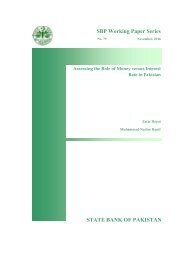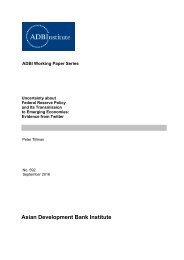SBP Working Paper Series STATE BANK OF PAKISTAN
n?u=RePEc:sbp:wpaper:74&r=mon
n?u=RePEc:sbp:wpaper:74&r=mon
Create successful ePaper yourself
Turn your PDF publications into a flip-book with our unique Google optimized e-Paper software.
calibrated value of Calvo price rigidity coefficient is quite low ( 0.25).<br />
Third, number of shocks is<br />
limited to only two. Finally, we abstract real fricitons.<br />
6. Conclusion<br />
In this paper, we establish some empirical `facts' pertaining to inter-linkages between the nominal and<br />
real variables of Pakistan economy using a comprehensive set of empirical tools for both annual and<br />
quarterly data.<br />
We find that all monetary aggregates are strongly pro-cyclical and some of them even act as a leading<br />
indicator of economic activity in Pakistan for the period 1990-2012. On the other hand, different nominal<br />
interest rates also co-moved positively with output and large scale manufacturing but real interest rates<br />
were countercyclical for the most part. Monetary aggregates and interest rates explain a quite limited<br />
portion of overall fluctuations in output and inflation.<br />
In addition, we also (theoretically) evaluated the role of money and monetary policy in propagating<br />
business cycle fluctuations of Pakistan economy using different ways of introducing the role of money via<br />
money in utility (MIU) and cash in advance constraint (CIA) as well as with different formulation of<br />
monetary policy either through a money growth rule or Taylor type interest rate rule.<br />
The results from our model simulations show that inclusion of money and the way it is incorporated in<br />
DSGE models makes significant difference in model performance. The cash economy models (MIU &<br />
CIA) under money growth rule exhibits better data matching potential as compared to cashless economy<br />
model closed by a Taylor type interest rate rule in case of Pakistan.<br />
The impulse response functions of various DSGE models show that under given modeling structure and<br />
parameterization, the impact of monetary policy shock on Pakistan economy was limited and short lived<br />
during the period of the study.<br />
P<br />
29






